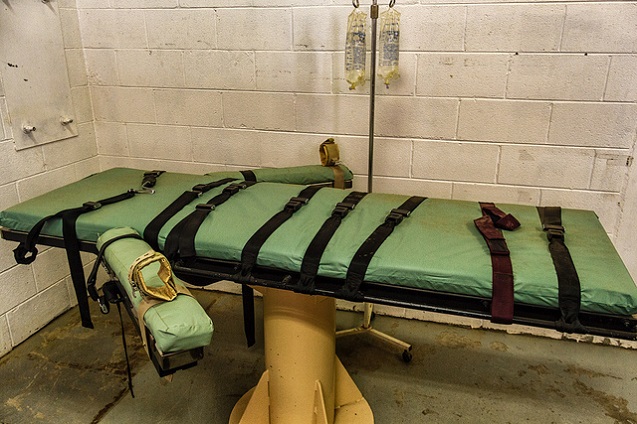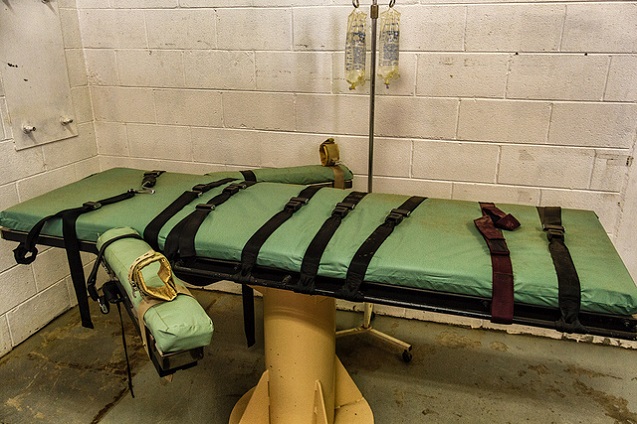
 Ken Piorkowski / Flickr)” width=”637″ height=”424″ />Lethal injection table. (Photo: Ken Piorkowski / Flickr)
Ken Piorkowski / Flickr)” width=”637″ height=”424″ />Lethal injection table. (Photo: Ken Piorkowski / Flickr)
Executions of three men in Oklahoma and Ohio have been postponed recently in the wake of controversy regarding the botched administration of lethal injections.
Capital punishment is by nature controversial. Can the state ever be 100 percent sure that the person sentenced to execution really committed the crime? Is there no possibility that evidence was overlooked or misinterpreted, that confessions were coerced or that there were mitigating circumstances? Looking at the photos of the three Oklahoma and Ohio men raises additional questions: Is it truly coincidental that all three are African-American? Can anyone truly believe that racism did not contribute to their death sentences when we know that African-Americans are incarcerated at nearly six times the rate of white Americans; that African-Americans are 14.2 percent of the total US population, but 34 percent of defendants executed since 1976; that the victims of nearly all lynchings throughout US history have been African-American? And ultimately, from a human rights angle, is it ever morally justified to sentence a person to death?
But the recent controversy is not about these ideological, ethical or sociological issues. The current controversy focuses on a single question: Is death by lethal injection “too painful” and therefore inconsistent with the Eighth Amendment, which prohibits cruel and unusual punishment? That question is, at heart, a medical question.
In our society, doctors function as the primary and often sole legitimate judges of pain. Doctors decide what constitutes “real” pain, who “really” is in pain and how pain should be treated. The monopoly of doctors over the treatment of pain is made clear by the anti-drug laws that have filled our courts and prisons with the many people incarcerated for “illicit” use of the very same medicines that doctors routinely prescribe. With the power to determine who is a drug seeker and who is a “legitimate” pain patient, physicians function as arbiters of the moral order. Of course, a great deal of the hands-on work of treating pain is delegated to nurses, paramedics and pharmacists. But only doctors hold the authority to make formal decisions regarding pain.
This has not always been the case. At other times in history and in other cultures, pain has been the province of shamans and priests, mothers and grandmothers. In other words, pain has been addressed as a moral, spiritual, relational or domestic challenge rather than (or in addition to) a medical one.
The medical monopoly over pain treatment is part of a much broader social process of characterizing problems or conditions in medical terms and adopting medical approaches to address those problems or conditions. This process, known as medicalization, is a hallmark of contemporary Western societies. Over the past century, more and more, phenomena, sensations and experiences have been drawn into the medical sphere. Pregnancy, childbirth, infant feeding, menopause, weight (too much or too little), sex drive (too much or too little), gender identity (think of gender reassignment surgery), anxiety, anger, depression, alcohol and drug dependence – and all sorts of physical “imperfections” from nose to breast size – are handled medically.
In medicalized cultures, physicians are employed to supervise, control and – when possible – correct those who are deemed “deviant.” Invoking an aura of scientific impartiality that other social institutions cannot easily claim, physicians determine eligibility for disability insurance (SSI and SSDI), justify – or not – insanity defenses, and write the prescriptions for the psychiatric medications so heavily used within the penal and welfare systems. While public acceptance of physicians as gatekeepers to social services, pain treatment and other desired goods is premised on the objectivity of science, there are, in fact, significant differences among physicians in how they rule regarding SSI and SSDI, what pain medications they prescribe, and how likely they are to support insanity defenses. Indeed, while we tend to assume that doctors’ first and only loyalty is to their patients, in the current health care reality, doctors generally are paid and employed by insurance companies, hospitals and government agencies (including prisons).
The transformation of capital punishment into a medical event is part of this broad cultural landscape. While the American Medical Association has ruled that physicians should not administer lethal injections, the fact remains that physicians helped design the lethal injection protocol. Lethal injections utilize standard medical materials such as intravenous lines, EKG machines and drugs obtained from pharmacies (barbiturates, pancuronium bromide and potassium chloride). Seventeen death penalty states require physician involvement and all practicing jurisdictions employ medical personnel, though not always doctors. Physicians monitor vital signs, declare death and sign death certificates. And doctors declare incarcerated people sufficiently “competent” for execution.
I want to be clear that only a tiny number of physicians actively participate in administering lethal injections. I also want to be clear that many doctors dedicate their lives to caring for those who are poor, afflicted and underserved. In the current climate of growing alliances between medical and penal institutions, my concerns are structural rather than personal. That does not, however, detract from what I see as a problematic cultural trend of defining and treating “deviance” in medical terms. Los Angeles County – the county with the largest number of incarcerated people in the country – has approved a plan to replace a jail with a correctional center designed to provide care for prisoners suffering from mental illnesses and substance abuse. In New Hampshire, the Department of Corrections is planning a new “gender sensitive” 224-bed prison designed for the particular needs of incarcerated women, most of whom have been identified as suffering from post-traumatic stress disorder as a result of sexual violence. The new prison intends to meet needs for “personal healing”: there is no discussion of the need for freedom or autonomy.
“Treatment” certainly sounds more benevolent than “punishment.” And it certainly is the case that the overwhelming majority of people serving time in US jails and prisons suffer from physical and mental health challenges. Yet the receipt of a psychiatric evaluation reduces a defendant’s chances of having his or her charges dropped. It also increases the likelihood of a conviction, a prison sentence, and a lengthier sentence at that. Given the gross overrepresentation of people of color in US jails and prisons, I worry that the medicalization of the penal system risks adding “insane” to the long list of incurable flaws assigned to black and brown Americans by white America. I worry that rebranding from “offender” to “sick” – instead of seeking new models that get at why people really are caught up in the system – encourages the proliferation of psychiatric medication to be used as chemical restraints (less visible but no less repressive than physical restraints.)
And I worry that utilizing standard medical equipment, procedures, materials and terminology to carry out executions sends the message that capital punishment is, if not therapeutic, at least okay.
48 Hours Left: All gifts to Truthout now matched!
From now until the end of the year, all donations to Truthout will be matched dollar for dollar up to $28,000! Thanks to a generous supporter, your one-time gift today will be matched immediately. As well, your monthly donation will be matched for the whole first year, doubling your impact.
We have just 48 hours left to raise $28,000 and receive the full match.
This matching gift comes at a critical time. As Trump attempts to silence dissenting voices and oppositional nonprofits, reader support is our best defense against the right-wing agenda.
Help Truthout confront Trump’s fascism in 2026, and have your donation matched now!